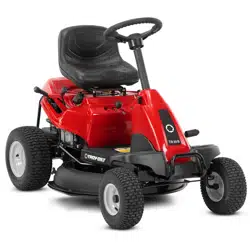Loading ...
Loading ...
Loading ...

27
SERVICE AND MAINTENANCE
CAUTION
If removing the battery for cleaning, disconnect the
NEGATIVE (-) (Black) wire from its terminal first, followed
by the POSITIVE (+) (Red) wire. When re-installing the
battery, always connect the POSITIVE (+) (Red) wire to its
terminal first, followed by the NEGATIVE (-) (Black) wire.
Be certain that the wires are connected to the correct
terminals; reversing them could result in serious damage
to your engine’s alternating system.
BATTERY FAILURES
Some common causes for battery failure are:
• Incorrect initial activation
• Overcharging
• Freezing
• Undercharging
• Corroded connections
These failures are NOT covered by your riding mower’s warranty.
JUMP STARTING
WARNING
Never jump start a damaged or frozen battery. Be certain
the vehicles do not touch and ignitions are off. Do not
allow cable clamps to touch.
1. Connect positive (+) (red) cable to positive post (+) of your
riding mower’s discharged battery.
2. Connect the other end of the cable to the (positive +) post of
the jumper battery.
3. Connect the second cable (negative – (black)) to the other
post of the jumper battery.
4. Make the final connection on the engine block of the riding
mower, away from the battery. Attach to an unpainted part
to assure a good connection.
CAUTION
If the jumper battery is installed on a vehicle (i.e. car,
truck), do NOT start the vehicle’s engine when jump
starting your riding mower.
5. Start the riding mower as instructed in the Operation section
of this manual.
6. Set the riding mower’s parking brake before removing the
jumper cables, in reverse order of connection.
CHARGING
WARNING
Batteries give off an explosive gas while charging. Charge
the battery in a well-ventilated area and keep away from
an open flame or pilot light as on a water heater, space
heater, furnace, clothes dryer, or other gas appliances.
CAUTION
Only use the approved charger for your battery type.
Reference your battery charger’s Operator’s Manual prior
to charging your riding mower’s battery. Always follow its
instructions and heed its warnings.
If your riding mower has not been put into use for an extended
period of time, charge the battery as follows:
1. For 30” deck models:
a. An AGM battery charger should be used. Recommended
charge rate is 1.1A to 14.8V.
IMPORTANT! Do NOT use an automotive charger.
b. If your battery charger is automatic, charge the battery
until the charger indicates that charging is complete. If
the charger is not automatic, charge for no fewer than
eight (8) hours.
2. For 24” deck models:
a. A voltmeter or load tester reading of 12.4 volts (DC) or
lower across the battery terminals indicates that the
battery needs to be charged.
b. A lead-acid battery charger should be used.
Recommended charge rate is 1A/14.7V.
c. If your battery charger is automatic, charge the battery
until the charger indicates that charging is complete. If
the charger is not automatic, charge for no fewer than
eight (8) hours.
FUSE
One 5A fuse is installed in your riding mower’s wiring harness
located just above the battery, under the left fender, to protect
the riding mower’s electrical system from damage caused by
excessive amperage.
If the electrical system does not function or your riding mower’s
engine will not crank, first check to be certain that the fuse
has not blown. It can be found at the rear of the riding mower,
underneath the fender located by the battery.
CAUTION
Always use a replacement fuse with the same amperage
capacity as the blown fuse.
Loading ...
Loading ...
Loading ...
